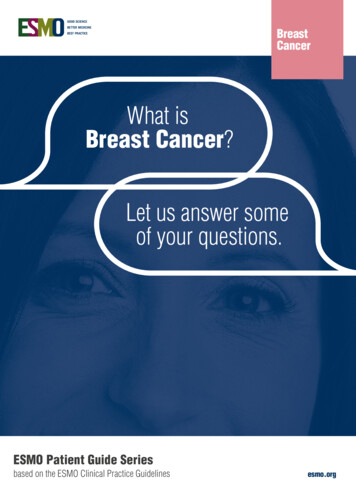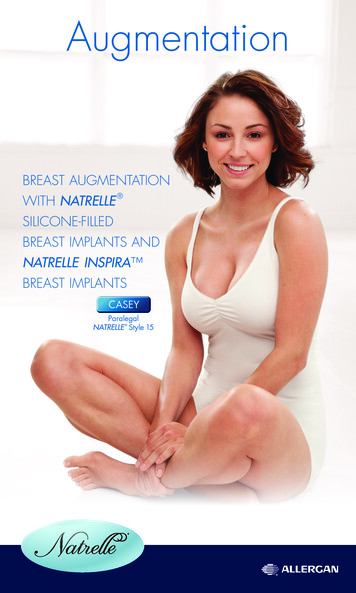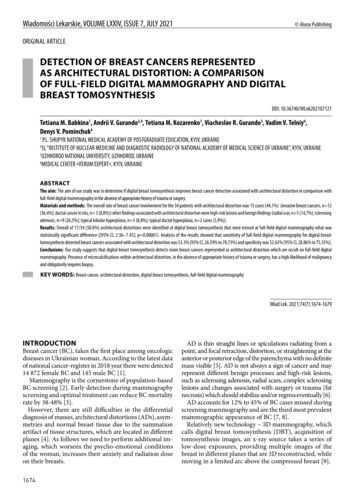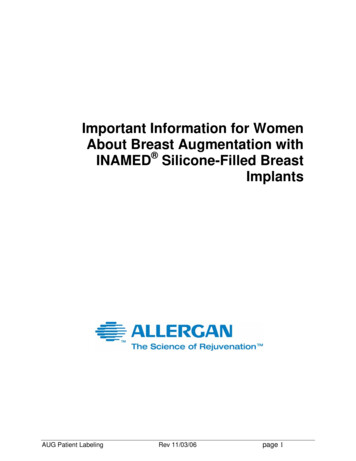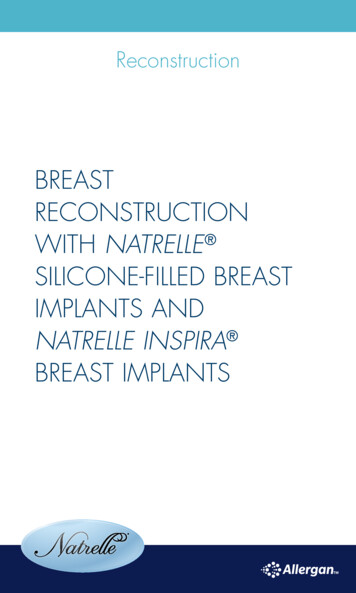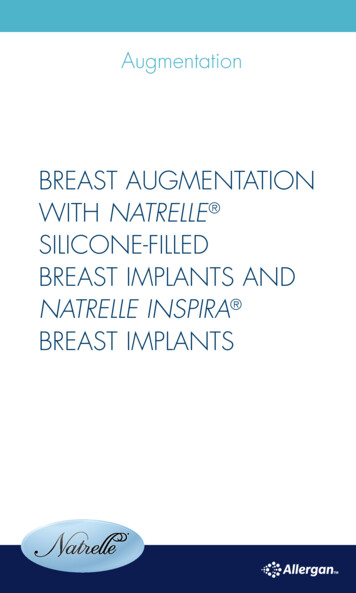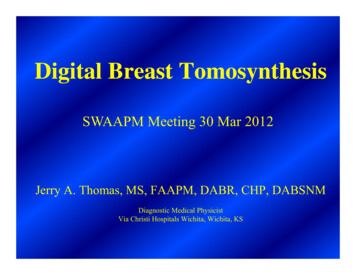
Transcription
Digital Breast TomosynthesisSWAAPM Meeting 30 Mar 2012Jerry AA. ThomasThomas, MSMS, FAAPMFAAPM, DABRDABR, CHPCHP, DABSNMDiagnostic Medical PhysicistVia Christi Hospitals Wichita, Wichita, KS
Talk Overview Breast Cancer Statistics Screen-Film Issues Tomosynthesish i–––––NeedClinical ExamplesScientific Studies on DBT vs. FFDMHow does it work?Image Display2
Acronyms in Digital Imaging FFDM – Full Field Digital Mammography– Also called Digital Mammography DBT – Digital Breast Tomosynthesis– Also called Tomosynthesis FDA “jargon”– PMA – Pre Market Approval– 510K3
BREAST CANCERSTATISTICS Estimated cases of Breast Cancer in 2010:210,000 Estimated Deaths from Breast Cancer in2010: 40,000 LifetimeLif i RiskRi k forf BreastBCancer:C1 ini 94
BREAST CANCERSTATISTICS 30% of all cancers are Breast Cancer 17% of all cancer deaths are from BreastCancer Breast Cancer is the leading cause of deathi women 40 - 44 yearsin Only 45% of women get ScreeningMammograms5
High Quality Mammography CONTRAST for Mass Identification RESOLUTION for Calcification Identification Low Patient Dose6
7
Primary Signs of Breast Cancer Mass Calcifications Mass and Calcifications8
Secondary Signs of Breast Cancer Skin ThickeningNipple InversionAdenopathyD l i DensityDevelopingD iArchitectural Distortion9
Performance of Screen/Film S/F mammography may have a miss rate of 20 –30% for breast cancer Sensitivity decreases as breast density increases10
Disadvantages of Screen-FilmScreen Film Short dynamicyrangeg– Low contrast– Under penetrationpof dense tissue Signal strength (screen thickness)compromises image quality (image blur) Film Processing– Time requiredq– 5 to 10 min– Artifacts Film ggrain noise11
Disadvantages of Screen-FilmScreen Film Can’t enhance or alter the imageg Large amount of physical storage space Must be physically transferred; only one placeat a time Information irretrievable if lost12
DIGITAL MAMMOGRAPHY13
Rembrandt Painting“Rembrandt’s Wife”14
Rembrandt’ss WifeRembrandt15
FFDM – Clinical Advantages No “filmfilm-typetype” artifacts Can see skin line without loss of contrast Faster Image acquisition– Images are available “immediately” after exposure– Increased patient throughput– Reduce patientpdiscomfort Decrease in BIRADS Category 0 Post-ProcessingPost Processing– Avoid call-backs for under exposure16
DIGITAL MAMMOGRAPHYSummary of Benefits Improved Image CONTRASTFLEXIBLE DisplayIImproveddPPatienti THROUGHPUTEasier Image Storage17
Tomosynthesis Designed to improve detection andcharacterization of breast lesions– Non-fatty breasts Multiple projections are reconstructed Allows visual review of thin breast sections–PPotentiali l to unmaskk cancers obscuredbd bybnormal tissue above or below lesion18
Why is There a Need for Tomosynthesis? In 2D FFDM:Tissue superimposition hidespathologies in 2DTissue superimposition mimicspathologies in 2DHologic – Proprietary and Confidential
Better Sensitivity ACR Phantom insert imagedwith 4 cm cadaverous breast Phantom has low contrast fibersfibers,masses, and calcifications Overlying breast tissue obscuresobjectj visibilityyReference: Andy Smith, “Overview of BreastTomosynthesis”, Hologic20
Better SensitivityDigital Mammogram 1X doseTomosynthesis 1X doseSlice at plane of phantom insertTomosynthesisTth i showshimprovedid lowl contrastt tvisibility over digital mammography21
Lower DoseDigital Mammogram 4X doseTomosynthesis 0.5X doseSlice at plane of phantom insertTomosynthesis shows improved low contrast visibilityover FFDM, even at much lower dose22
Digital Breast Tomosynthesis (DBT)— VisualizationA DBT reconstruction- 30-80 slices parallel to thedetector plane- 1mm slice thickness- 100 µm in-plane pixel sizeVisualization software functions- Paging through DBT slices- Window level- Zoom in / zoom out- Field of view magnifierThe knowledge for interpretingconventionaltil mammographyh iisvalid for DBTCourtesy of Tao Wu, Ph. D and Massachusetts General Hospital23
Breast TomosynthesisA three-dimensionalthree dimensional mammographic examinationthat can minimize the effects of structureoverlap within the breast24
Breast Tomosynthesis Preserves the very highresolution of 2D FFDM Multiple images of the breast areacquired at different anglesduring a sweep of the x-rayx ray tube Allows radiologistsgto see aroundoverlapping structures
Hologic Selenia Dimensions DBT 2D or 3D imaging– 2D onlyl– 3D only Combo mode– 3D image– Return to 0 degreesgfor 2D imageg– Single compression for both images26
How Does Hologic’s Tomosynthesis Work? Tube moves in a 15 arc 15 low dose images are acquired 1 image at each degree Four second sweep Total dose one 2D mammogram Images are reconstructed into 1 mm slicescombo--modecombo Inimaging, 2D and3D iimages are ttakenk underd theth samecompression, with no additional patientpositioning required. Combo supports bothCC and MLO projections.projectionsCompression PaddleCompressedpBreastDetector Housing
Potential Benefits of 3D Imaging Better imaging– Improved lesion margin visibility– Precise lesion localization– Identification and location of multimulti-focalfocal cancers Higher accuracy– Increased breast cancer detection– Higher PPV for breast biopsy recommendations– Decreased workup rate for non-cancer cases LLower recallll ratest– Decreased workup rate for non-cancer cases28
Hologic ROC Study for FDAPMA29
ROC Study Design 1083 women were recruited from 5 clinicalcenters– 856 presented for screening mammography– 227 presented for breast biopsy All subjectsjreceived 2D and 3D imagesg ofboth breasts in CC and MLO positions Radiation dose for a single 2D plus 3Dacquisition (either CC or MLO) was lessthan the MQSA limit for a single 2Dmammogram30
Overview of Reader Study Comparison of 2D to 2D plus 3D Two retrospectivei Independentdd Readerd StudiesS di Readers were MQSA qualified– Wide range of experience in 2D Reader study enriched with:– CCancer cases– Recalled screening cases– Benign biopsy cases Major conclusions– Improved area under ROC curve– Reduced recall rate31
Rationale for using 2D plus 3D Comparison of current images with prior images is standardmammography practice and critical to perceive subtle changeswhich may be associated with a cancer. Obtaining a 2D exam along with the 3D exam will allow directcomparison of current 2D images with prior 2D images Segmental and clustered calcifications are more easily andquickly appreciated with 2D because they can traverse multipleslices in 3D. By minimizing structure overlap, 3D optimally demonstratesmasses and architectural distortion32
Reader Study #1 Pooled ROC Curves for12 Readers Significant increase inperformance60% increased to 78%Hologic – Proprietary and Confidential33
Reader Study 2 Pooled ROC Curves for15 Readers Identical Results from 2independent reader studies Significant increase inperformance60% increasedid tot 76%Hologic – Proprietary and Confidential34
Reader Study 1 & Reader Study 2Pooled ROC Curves Pooled ROC Curves for 2Reader Studies Almost complete overlapbetween the two studiesHologic – Proprietary and Confidential35
Pooled ROC ResultsWith three points to illustrate trade off between cancerdetection and recall rate changesCancer DetectionIncrease16%8%0%Recall RateReduction0%‐25%25%‐40%2D pplus 3D2DAUC diff 0.072, p‐value 0.0001Hologic – Proprietary and Confidential
Reader Study 2: Pooled ROC CurvesReader Study 2 added a3D MLO viewIncreased sensitivity anddecreased recall rateHologic – Proprietary and Confidential37
Performance in Dense BreastsTomo improved ROC performance in fatty breastsIn dense breasts, ROC performance increased 3X that of fattyConclusion: Tomo useful in fatty breasts, more useful in dense breastsFatty – BIRADSdensity 1 or 2Hologic – Proprietary and ConfidentialDense – BIRADSdensity 3 or 438
What are the benefits of Combo-mode* The ROC analysis demonstrated that 2D plus 3D issuperior to 2D alone The ROC results showed that for a given sensitivity,the recall rate should be lower using tomosynthesis The ROC results showed that at a given recall rate,sensitivityses v y shoulds ou d be higherg e ususingg tomosynthesiso osy es s The ROC analysis demonstrated that theperformance of all ppparticipatingpg radiologistsgimproved, regardless of experienceNone of these statements could be said for the transitionfrom Analog to Digital Mammography *The Hologic Selenia Dimensions clinical studies presented to the FDA as part of Hologic’s PMAsubmission that compared Hologic’s Selenia Dimensions combo‐mode to Hologic 2D FFDM39PRE‐00023
TTomosynthesish i TechnologyT h lPutting it all together
The technology behindtomosynthesis Underlying technologies––––Digital detectorsX-ray unitReconstruction algorithmsImage Display41
Engineering constraints Total radiation doseImaging timePatient motionDDetectorperformancefDetector motionAbility to image entire breastNeed to provide for biopsy of lesions onlydetected by DBT42
Design Approach Arc of movement– (11 – 60 Degrees) Number of projections– (9 – 25) Exposure– Continuous or pulsed Detector Exposure parametersTotal DoseEffective size of pixelsX-rayy source / filterSingle or binned pixelsPatient position– Fixed or moved43
IMAGE GENERATION44
Schematic of TomosynthesisPark J M et al. Radiographics 2007;27:S231-S24045
Projection of Objects in BreastPark J M et al. Radiographics 2007;27:S231-S24046
Reconstruction Algorithms Shift-and-addTuned Aperture CTMatrix InversionFil d backFilteredb k projectionj i (FBP)Maximum likelihood reconstruction (ML)Simultaneous algebraic reconstruction (SART)Gaussian frequency blending (GFB)Voting strategy47
Basic Principle ofSlice ReconProjection 1Shift each projection left orright then add to get the planeProjection 2Projection 348
Basic Principle ofSlice ReconShift RightShift each projection left orright then add to get the planeNo ShiftShif LeftShiftfAdd shifted images toget final slice image49
Basic Principle ofSlice ReconShift LeftShift each projection left orright then add to get the planeNo ShiftShif RightShifti hAdd shifted images toget final slice image50
Shift and AddPark J M et al. Radiographics 2007;27:S231-S24051
Image Display Single Slice Slab Recon––––ArithmeticGeometricCubicOth ?Other? MIP52
MIP of slices showing Calcifications53
MIP of slices showing speculated lesionsStatusEND54
Clinical Image TOC Better Visualization Recall Reduction– Tissue superimposition – mimicking Cancer InvasiveInasi e DuctalD ctal Carcinoma (IDC)Micropapillary type Ductal CarcinomaMetastasis from endometriod carcinomaArtifacts55
Clinical Data AcknowledgementImages and data courtesy of: Hôpital Privé d’Antony, Paris France Massachusetts General HospitalHospital, Boston MA USA Netherlands Cancer Institute –Antoni Van Leeuwenhoek Hospital, Amsterdam Holland Centre de Radiologie et dd’EchographieEchographie du Docteur Joussier,Joussier Paris France Dartmouth Hitchcock Medical Center, Lebanon NH USA Magee Women’s Hospital, Pittsburgh PA USASlides courtesyy of: Andy Smith, Ph.D. Hologic, Inc56
Better Visualization Example 1
LCCA 2D Mammography Image2DHologic – Proprietary and Confidential58
LCCA suspiciousi iarea ini a 2D MammographyMh ImageI2DHologic – Proprietary and Confidential59
The 2D Mammography Image next to one slice of a 3D Image Set2D3DThe Difference is ClearHologic – Proprietary and Confidential60Status
Recall ReductionSuperimposed Tissue Examples
A 2D Mammography Image witha suspiciousarea next to a 3DRCCimage set2DHologic – Proprietary and ConfidentialRCC3D3DClick image torun 3D in cine62
Slice3026221418Steppingpp g thru the imagegset, shows that thesuspicious area is nothingmore than normal breaststructures overlappingHologic – Proprietary and Confidential63Status
Recall Reduction – Superimposed Tissue (Case 2)Hologic – Proprietary and ConfidentialClick image torun 3D in cine64Status
Invasive Ductal Carcinoma (IDC)Hologic – Proprietary and ConfidentialClick image torun 3D in cine65
IDC - Region of Interest2DHologic – Proprietary and Confidential3DClick image torun 3D in cine66Status
Micropapillary type ductalcarcinoma in situ in 65 y/owomanAdjacent ductal extensionPark J M et al. Radiographics 2007;27:S231-S240Movie 367
Metastasis from endometriodcarcinoma in 59 y/o womanDBT3 primary masses(see arrows)Park J M et al. Radiographics 2007;27:S231-S240Mass not seenon FFDMMovie 468
Artifacts69
Artifacts due to largeC l ifi tiCalcificationArtifact from largecalcification(white arrow)On basis of USappearance MassDx as CystPark J M et al. Radiographics 2007;27:S231-S240Movie 7
Needle ArtifactWu, T. et al. Med Phys 33 (7), Jul 200671
Large Calcification ArtifactWu, T. et al. Med Phys 33 (7), Jul 200672
Small Calcification ArtifactWu, T. et al. Med Phys 33 (7), Jul 200673
Tomosynthesis Status Hologicg tomosynthesisyFDA approvedpp Tomosynthesis considered a new modality by FDAoda t es requireequ e 8 hoursou s ofo trainingtag priorp o to New modalitiesdoing unit surveys. OtherOh CCompaniesi workingki on DBT GE Siemens Philips (Sectra) Planmed GiottoEND
Hologic Tomosynthesis Unit 15 projections over 15 degrees continuous arc – 3.7 ms scan Rule of thumb is one projection per degree Reduces artifacts from calcification ProvidesP id betterb tt visualizationi li ti off spiculationsi l tiandd masses During projections, detector moves 5 degrees about CR Angulation corrected in reconstruction Using back projection reconstruction because it’s faster Most important are reconstruction filters Pixels binned to 140 microns/recon to 95 Slice thickness of 1mm75
GE Tomosynthesis Collect 9 projections over 25 degreesUse step and shoot exposuresReconstruct 0.5 to 1.0 mm slicesBin them into 1cm slabs (overlap 0.5 cm)Goal to do screeningg with MLO view onlyy– Use dose equivalent to CC or MLO Preparing to submit for FDA approval76
Siemens Tomosynthesis Collect 25 projections over 50 degreesUse step and shoot exposures85 um aSe detectorReconstruct to 1 mm slices77
Philips (Sectra) TomosynthesisOne single scan with continuous readread-outout of the detector to obtain 3D dataEach detector line will obtain data from a different angle Photon Counting Detector Move axisi off rotationi pivotipoint under detector for 3D78
Giotto DBT ProjectionsEND79
“Coming Attractions” New X-ray tube TechnologyContrast Enhanced DMDual Energy Contrast Enhanced DMSSpectrall IImagingi vs. DualD l EnergyEMulti-modality Imaging80END
Carbon Nanotube X-rayy Prototypeyp81
Contrast Enhanced DigitalMammographyh CEDMC GE SenobrightFDA approvedd ffor salel iin ththe USChange filter and algorithms onlyNo hardware change requiredHaven’tt found uptake kinetics clinically helpfulHavenDose 20% higher-1.5 mGy/view
Temporal CEDMTemporal CEDM 3-7 images at high kVp (45-49) Dose/image typically 5x lowercompared to standard MX Mask image before injectionmaskimage50t 60s60180Iodine injectionImages courtesy of Dr DiekmannCharité – Berlin, Germanyt 0s30t 120st 180s300Technique :Mo/Cu, 45kV,100mAsT 60 – T 0T 120 – T 0T 180 – T 083
Temporal CEDMCEDMimageCase62 yyear-oldPhysical examinationNon palpable lesionMammography- 1 stellate opacity- 1 round opacity70V a ri a tti o n e n n i v e a u x d e g r i s6050Conventional Mammograms40302010Images courtesy of Dr Dromain,Institut Gustave Roussy – Villejuif, France0010084200Temps (s)300400500
Dual Energy CEDMDual-EnergyDualEnergy CEDM 1 image at low kVp, 1 image at high kVp (45-49) low kVp image just before high kVp imagelow kVpimage0high kVpimageTime (s)120 120Iodine injection600001600ConventionalMammogramCEDM imagenb photons/mAs/mm² at 750mmHigh u44kVnb photons/mAs/mmm² at 750mmLow EnergyRh/Rh28p) gy(keV)Images courtesy of Dr Dromain,Institut Gustave Roussy – Villejuif, France140030 Iodine35K-edge4045500510152025energy(keV)30 Iodine3540K-edge854550
Dual Energy CEDMCEDMimageCase 4ConventionalMammogramsCEDMimagePhysical examinationNormalMammographySmall massonly visible on CC view Low confidence ofppresence GlobalclassificationBIRADS 3UltrasonographyRMLO 2 minRCC 4 minnormal(performed by referring physician)Images courtesy of Dr Dromain,Institut Gustave Roussy – Villejuif, France86
Spectral Imaging vs DualDual-EnergyEnergySpectral imaging:d l exposuresdualPhoton-counting:single exposureSpectrum after breastSpectra after breast141816Fluencee(10 6ph./cm 2)Fluence (10 6phot/cm 2)121410128Rh106Cu4IodineK-edge86420021020Energy (keV)30400101520253035Energy (keV)Non-overlapping spectra better tissue cancellationConcentrated around K-edge improved I-contrast40452ndthreshold87
Spectral imaging an alternative toMR?88
Ultrasound / X-rayy Data FusionSagittal USMammogramAxial USCoronal US89
AcknowledgementsgThanks for input from: HologicHl iGE HealthcareSiemens HealthcarePhilips HealthcareGiottoTao Wu, Ph.D.Andy Smith, Ph.D.90
Thank you for your attentionDon’t let the Sharks BITE!!91
Just the Sail Fish92
HAVE A WONDERFUL DAY!!93
My contact info:jerry.thomas@viachristi.org
Hôpital Privé d'Antony, Paris France Massachusetts GeneralGeneral HospitalHospital, BostonBoston MAMA USAUSA Netherlands Cancer Institute - Antoni Van Leeuwenhoek Hospital, Amsterdam Holland CentreCentre de Radiologie et dd Echographie'Echographie du Docteur Joussier, Paris France
